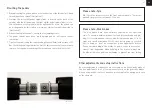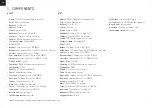
EN
30
6.
DRIVE - FUNCTION CHECK
Unusual running noise
[e.g. a cracking sound during pedalling]
1. First of all, check whether the pedal has loosened.
2. Should this be the case, tighten the pedal with a torque of 35 Nm (see above).
3. Also check the bearing clearance of the pedals, as this bearing position is pro-
ne to wear and tear, which might cause noise to develop. For this purpose, grip
the pedal with both hands in the manner shown in the photo and tilt or turn it.
[Illustration 13]
4. The clearance of the bearings in the pedal can be adjusted. In this case, plea-
se turn to your specialist dealer or contact MÖVE directly.
5. Should the noise be emanating from the cyfly® drive, please turn to your spe-
cialist dealer or contact MÖVE directly.
cyfly® drive bearing play
The cyfly® drive exhibits a system-related (gear drive) bearing play in peripheral
direction. With horizontal alignment of the pedal cranks, one of the pedals (with
the other one locked into position) can be moved up and down by up to 1 mm. The
curbing effect of the special oil we use makes this bearing play hardly noticeable
when the bicycle is in use.
The bearing play in axial direction can be checked in the following way: Turn the
respective pedal crank until it is aligned with the saddle tube of the bicycle frame.
Alternatingly push the pedal towards the saddle tube and then away from it.
Should you notice an unusual bearing play in radial direction or peripheral directi-
on, please discontinue your ride and turn to your dealer or contact MÖVE directly.
You can check the following connections:
• Interface cyfly® frame
2x M8, Allen key 6mm, 24 Nm [Illustration 14]
Please note: this connection is also used for the easy dismantling and
replacement of the entire cyfly® drive.
• Offset - carrier:
M12, Torx T40, 30 Nm [Illustration 15]
• Pedal crank clamping:
2xM5, 6 Nm, Torx T25 [Illustration 16]
All screws used for the cyfly® drive have been designed or selected to have a
so-called minimum clamping length. During cyfly® assembly, the screws are
brought to their required pre-tension. The torque required for this purpose is
monitored for every screw connection. Moreover, all screws are mounted (medi-
um-tight) with screw lock. The corresponding torque for each screw is indicated
in the “Tightening torque” table in Chapter 7 Page 32.
Illustration 13
Please note: The sound of the chain on the cogwheel is quite normal and
is generally overlaid by the general sound of the chain, the motion of the
wheels and the gearshift when the bicycle is in use.
Summary of Contents for franklin
Page 1: ...DE 1 HANDBUCH MANUAL franklin ...
Page 2: ...DE 3 SPRACHEN LANGUAGES DE EN 4 19 20 35 ...
Page 3: ...DE 4 TURN THE PAGE DE 4 ...
Page 19: ...EN 20 TURN THE PAGE EN 20 ...
Page 26: ...EN 27 ...
Page 35: ...WWW MOEVE BIKES COM ...







































